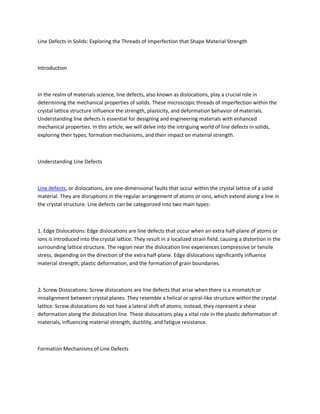
Line defects
- 1. Line Defects in Solids: Exploring the Threads of Imperfection that Shape Material Strength Introduction In the realm of materials science, line defects, also known as dislocations, play a crucial role in determining the mechanical properties of solids. These microscopic threads of imperfection within the crystal lattice structure influence the strength, plasticity, and deformation behavior of materials. Understanding line defects is essential for designing and engineering materials with enhanced mechanical properties. In this article, we will delve into the intriguing world of line defects in solids, exploring their types, formation mechanisms, and their impact on material strength. Understanding Line Defects Line defects, or dislocations, are one-dimensional faults that occur within the crystal lattice of a solid material. They are disruptions in the regular arrangement of atoms or ions, which extend along a line in the crystal structure. Line defects can be categorized into two main types: 1. Edge Dislocations: Edge dislocations are line defects that occur when an extra half-plane of atoms or ions is introduced into the crystal lattice. They result in a localized strain field, causing a distortion in the surrounding lattice structure. The region near the dislocation line experiences compressive or tensile stress, depending on the direction of the extra half-plane. Edge dislocations significantly influence material strength, plastic deformation, and the formation of grain boundaries. 2. Screw Dislocations: Screw dislocations are line defects that arise when there is a mismatch or misalignment between crystal planes. They resemble a helical or spiral-like structure within the crystal lattice. Screw dislocations do not have a lateral shift of atoms; instead, they represent a shear deformation along the dislocation line. These dislocations play a vital role in the plastic deformation of materials, influencing material strength, ductility, and fatigue resistance. Formation Mechanisms of Line Defects
- 2. Line defects can form through various mechanisms, either during material processing or as a result of external forces acting on the material. Some common formation mechanisms include: 1. Plastic Deformation: Line defects can form during plastic deformation processes such as bending, stretching, or compression. The application of stress causes dislocation motion, leading to the formation of new dislocations or the multiplication of existing ones. 2. Crystal Growth: Line defects can form during the crystallization process when the atoms or ions arrange themselves into a perfect lattice. The formation of dislocations can occur due to imperfections or irregularities in the crystal growth process. 3. Thermal Activation: Elevated temperatures can promote the movement of atoms or ions, leading to the formation and migration of dislocations. This thermal activation mechanism is particularly significant in processes such as annealing or high-temperature deformation. Impact on Material Strength Line defects have a profound influence on the mechanical properties of materials, particularly their strength and plasticity. The presence of dislocations affects materials in the following ways: 1. Material Strength: Dislocations provide a mechanism for plastic deformation in materials, allowing them to deform under applied stress. The movement of dislocations enables materials to withstand higher loads and increases their yield strength and ultimate strength. 2. Ductility and Toughness: Dislocations promote material ductility, enabling materials to undergo large deformations before fracturing. They also contribute to the energy absorption capacity of materials, enhancing toughness and resistance to fracture. 3. Work Hardening: As dislocations move and interact, they hinder the motion of other dislocations, leading to work hardening. Work hardening increases material strength and hardness through the accumulation and entanglement of dislocations.
- 3. 4. Fatigue Resistance: The presence of dislocations can either enhance or reduce a material's resistance to fatigue failure, depending on their distribution and interaction with other defects. Proper management and control of dislocations can improve a material's fatigue life. Conclusion Line defects, or dislocations, are critical threads of imperfection within the crystal lattice of solid materials. They significantly impact material strength, plasticity, and deformation behavior. Edge dislocations and screw dislocations play distinct roles in material behavior, influencing mechanical properties such as strength, ductility, and fatigue resistance. Understanding the formation mechanisms and effects of line defects allows scientists and engineers to tailor materials with enhanced mechanical properties for various applications. By unraveling the secrets of line defects, we gain insights into the threads that shape material strength, empowering us to design and engineer advanced materials with superior mechanical performance.